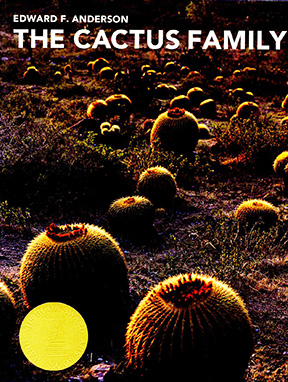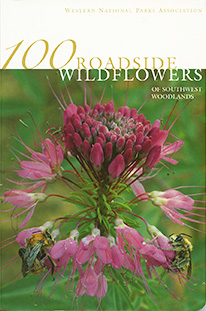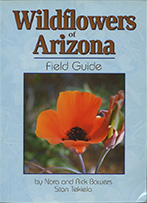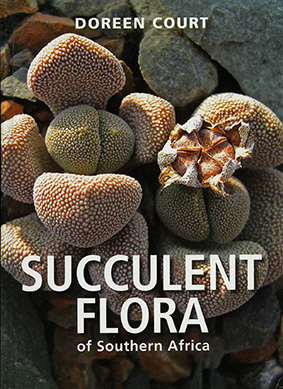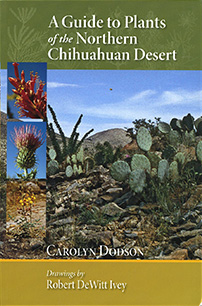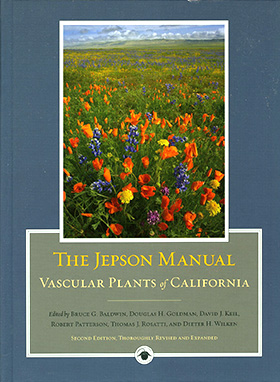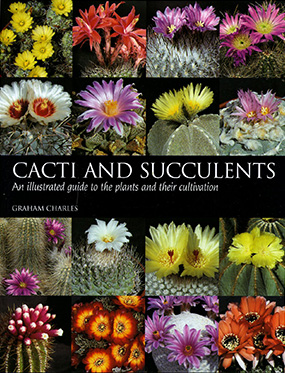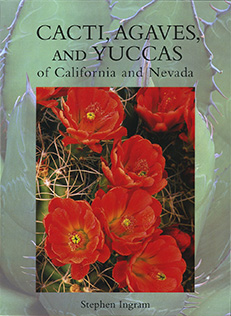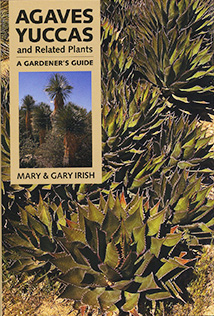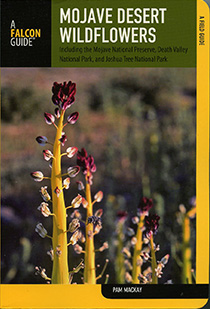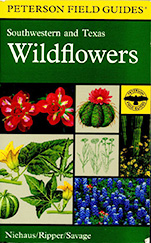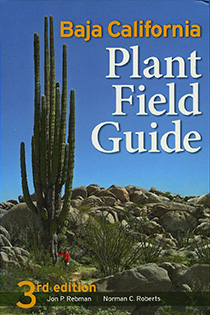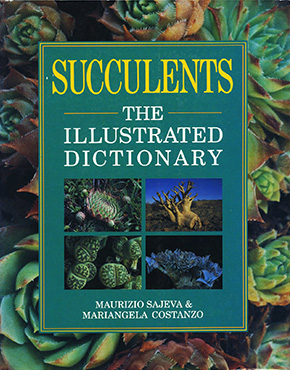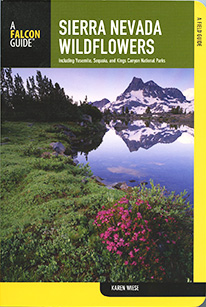
Arid Climate Plants Bibliography

|
|
Succulents—plants that store extra water in their leaves or stems to survive in dry climates—are covered in this bibliography. These plants include cacti, aloes, agaves, and many euphorbias. Many general purpose books also cover arid climate plants, so check the other bibliographies too. Note: book cover sizes in the list below are shown relative to each other. The list is organized by primary author. Some out-of-copyright books are available free at the supplied links. |
|
Author(s): Anderson, Edward F. Publisher: Timber Press, 2001 ISBN: 978-0881924985 Comments: This beautiful 776-page encyclopedic reference covers the cactus family, encompassing 125 genera and 1810 species of cacti from all over the world. Descriptions are detailed, but the author successfully minimizes specialized botanical jargon. There are 1000 high quality photographs, and the native range of each species is described. Plants are ordered by genus and species. This book is an encyclopedia, not a field guide—it lacks identification guides such as dichotomous keys or indices based on shape or color—so you will need other guides to assist with initial IDs. Other arid climate plants such as aloes, agaves, and succulent Euphorbias are not included. But this book is the modern day standard for cacti. |
Worldwide coverage. |
|
100 Roadside Wildflowers of the Southwest Woodlands Author(s): Bowers, Janice Emily Publisher: Western National Parks Association, Tucson, AZ, 2003 ISBN: 978-0911408737 View at: Barnes & Noble, or Amazon Comments: This is the kind of book you buy on impulse when you stop at a visitor stand in a national park. It allows identification of some of the most common flowers in woodland habitats, but the American southwest is a large region and the 100 species covered provide only a tantalizing glimpse. Plants are presented two per page, with a nice photograph and clear, non-technical descriptions. There is no special organization to the presentation, but the book is short enough so it is possible to flip through it in search of an ID. |
Arizona, New Mexico, Utah, Nevada, Colorado |
|
Author(s): Bowers, Nora & Rick, Tekiela, Stan Publisher: Adventure Publications, Inc., 2008 ISBN: 978-1591930693 View at: Barnes & Noble, or Amazon Comments: This compact 432-page guide describes about 200 wildflowers. Facing pages include a photo and a non-technical description. |
Arizona |
|
Author(s): Bowers, Nora and Rick; Tekiela, Stan Publisher: Adventure Publications Inc., 2008 ISBN: 978-1591930686 View at: Barnes & Noble, or Amazon Comments: This compact guide, 236 pages in length, describes about 50 common cacti found in Arizona and, typically, surrounding states. Cacti are organized by stem type, a readily identifiable feature, into cylindrical, segmented, stick-like, and columnar stems. Typically a main photo is complemented by three smaller photos of plant details. Descriptions cover plant features and list similar species. |
Covers Arizona. Duh. |
|
The Cactaceae: Descriptions and Illustrations of Plants of the Cactus Family Author(s): Britton, Nathaniel Lord, Rose, J. N. Publisher: Press of Gibson Brothers, 1919 View at: Download free from the Biodiversity Heritage Library |
||
|
Succulent Flora of Southern Africa Author(s): Court, Doreen Publisher: Struik Nature, Cape Town, South Africa, 2010 ISBN: 978-1770075870 View at: Barnes & Noble, or Amazon Comments: Southern Africa has the most diverse array of succulents anywhere in the world. Succulents, which adapt to dry conditions with thick, water-storing leaves and stems, exist in all arid climates. Nobody knows why they are especially prevalent in southern Africa, or why so many unique species are present there. This work, now in its third edition, apologizes for its lack of comprehensiveness, but there is little else that even comes close. The photography is excellent and the descriptions are thorough. Species are arranged by family, an arrangement that seems especially well-suited for arid climate plants. If you are lucky enough to spend time in the region, this is an excellent resource. It is also a great resource if you love these plants. 336 pages. |
Southern Africa, including Namibia, South Africa, Botswana, southern Zimbabwe, southern Mozambique, Swaziland, and Lesotho. |
|
A Guide to Plants of the Northern Chihuahuan Desert Author(s): Dodson, Carolyn; Ivey, Robert DeWitt (illus.) Publisher: University of New Mexico Press, 2012 ISBN: 978-0826350213 View at: Barnes & Noble, or Amazon Comments: Plants are organized by plant group, then flower color. Although the Chihuahuan desert spans southern New Mexico and portions of northern Mexico, the northern portion of this desert lies primarily within New Mexico. Many of the plants are present in a wider range of the American southwest as well as Mexico though. Plant descriptions cover ecological aspects, medicinal uses, and interesting stories. About 75 species are described. 194 pages. |
Northern Chihuahuan desert |
|
The Jepson Manual: Vascular Plants of California Author(s): Editors: Baldwin, Bruce G.; Goldman, Douglas H.; Keil, David J.; Patterson, Robert; Rosatti, Thomas J.; Wilken, Dieter H. Publisher: University of California Press, Ltd., 2012 ISBN: 978-0520253124 View at: Barnes & Noble, or Amazon Comments: Producing a comprehensive assessment of the plants in even a typical state is a task of monumental proportions. For a state that is larger than most countries, one that spans a huge range of latitudes and altitudes, which experiences nearly every extreme of temperature, precipitation, and growing season, it is almost inconceivably hard. The Jepson Manual is justifiably famous for its scope and detail. Covering 7,600 species, it substantially outstrips other flora references. Comprised of a mere 1568 pages printed at a size small enough to demand a magnifying lens, it includes comprehensive keys, detailed descriptions, and detailed line drawings of species. Like most comprehensive flora, the Jepson Manual is not for amateurs. It is targeted firmly at botanical pros who annotate species and track how they change in response to changes in climate. If you are such a pro; you probably already have a copy; if not, you can find its information online in the Jepson eFlora. |
California |
|
Cacti and Succulents: An Illustrated Guide to the Plants and Their Cultivation Author(s): Graham, Charles Publisher: Crowood Press Ltd., 2003 ISBN: 978-1861268723 View at: Barnes & Noble, or Amazon Comments: Lavishly illustrated with beautiful photographs, this book describes about 250 species of succulent plants. It is not a field guide; instead, it is intended for those who enjoy selecting and growing their own plants, or simply admiring their beauty. Many of the plants are photographed in their natural habitats. Descriptions and range maps are not present. 192 pages. |
|
|
Cacti, Agaves and Yuccas of California and Nevada Author(s): Ingram, Stephen Publisher: Cachuma Press, 2008 ISBN: 978-0978997106 View at: Barnes & Noble, or Amazon Comments: This book describes only 60 species, but it does so beautifully, with well-written articles, excellent photography, stunning botanical drawings, and detailed range maps. Includes 262 color photos. From the back cover: "Much more than a field guide, this book examines the natural history of California's and Nevada's cacti, agaves, and yuccas, including their origins, ecology, and conservation." You'll need other books to complement this one for identification of this broad group of plants, but this is an attractive, readable, interesting book. 243 pages. |
California and Nevada. |
|
Agaves, Yuccas and Related Plants: A Gardener’s Guide Author(s): Irish, Mary & Irish, Gary Publisher: Timber Press, 2000 ISBN: 978-0881924428 View at: Barnes & Noble, or Amazon Comments: This book describes 90 species, with about 100 color photographs and 18 drawings. Described as a gardener's guide, it is also an excellent field guide, including detailed descriptions and range information. 312 pages. |
North America. |
|
Wildflowers of the Western Plains Author(s): Kirkpatrick, Zoe Merriman Publisher: University of Nebraska Press, 1992 ISBN: 978-0803219052 View at: Barnes & Noble, or Amazon Comments: 186 species are presented, organized by family. Within a family, a cluster of photos precedes detailed descriptions of the species. This organization makes it easier to compare family members. Descriptions include the plant, flower, fruit; its range, and other remarks that are most often related to making a successful identification. Photos are high in quality. 240 pages. |
The plains of Western Texas, eastern New Mexico, through Colorado, Kansas, Nebraska, Wyoming, Montana, Dakotas, and into Canada. |
|
Author(s): MacKay, Pam Publisher: Morris Book Publishing, LLC, 2013 ISBN: 978-0762780334 View at: Barnes & Noble, or Amazon Comments: This book covers the Mojave Desert, including Death Valley National Park, Mojave National Preserve, and Joshua Tree National Park. It provides detailed descriptions and excellent photos for over 300 plants. Descriptions are clear and free of jargon. Note the difference between the 2003 edition (left) and the 2013 second edition. 337 pages. |
Mojave Desert: Parts of southern California and Utah, and small parts of Arizona and Utah. Includes the Mojave National Preserve, Death Valley National Park, and Joshua Tree National Park |
|
Peterson Field Guides: Southwestern and Texas Wildflowers Author(s): Niehaus, Theodore F., Ripper, Charles L., Savage, Virginia Publisher: Houghton Mifflin, 1984 ISBN: 978-0395936122 View at: Barnes & Noble, or Amazon Comments: Describes over 1500 species of wildflowers found in portions of the southern and southwestern United States. Employs black & white line drawings, and some paintings, pointing out identifying features with arrows. Plants are presented by flower color, then organized by other identifying features such as flower shape, family, or seed appearence. Text descriptions are short, but focused on positive identification. |
|
|
Author(s): Preston-Mafham, Ken Publisher: Firefly Books, 2007 View at: Barnes & Noble, or Amazon Comments: This book presents 500 species of cacti, arranged by genus and species. It is an encyclopedia, not a field guide, in that it lacks keys or any organization necessary for identifying an unknown. It is targeted at cactus enthusiasts. Each page includes a photo, descriptive information, range information, and a discussion. 528 pages. |
North, Central and South America. |
|
Baja California Plant Field Guide Author(s): Rebman, Jon P.; Roberts, Norman C. Publisher: Sunbelt Publications, 2012 ISBN: 978-0916251185 View at: Barnes & Noble, or Amazon Comments: The Baja California peninsula spans a large latitiude range, as well as a surprising range of altitudes and levels of precipitation. The variety of plant species reflects this range of habitats. This book presents 715 species, organized by plant family, including excellent photos, descriptions, folklore, habitat information, etc. Organization by family seems particularly well-suited to arid climate plants. Discussions on geography, climate, pythogeography, invasive plants, conservation, and other topics precede the identifier. The plants covered include vascular plants (ferns, flowers, trees, cacti, etc.) and non-vascular plants (lichens, bryophytes). The authors have extensive credentials, and many of the plants described here are also found in southern California and other parts of northwestern Mexico. The text is readable, not overly academic. 480 pages. |
Baja California peninsula, southern California, northwestern Mexico. |
|
Succulents: The Illustrated Dictionary Author(s): Sajeva, Maurizo & Costanzo, Mariangela Publisher: Timber Press, 1994 ISBN: 978-0881923988 View at: Barnes & Noble, or Amazon Comments: Contains 1200 excellent photographs covering roughly the same number of species from more than 195 genera of succulent plants. This is not a guide book—entries are organized by genus and species. Organized with six items per page, descriptions are a bit anemic. 238 pages. |
Worldwide. |
|
Guide to Succulents of Southern Africa Author(s): Smith, Gideon F.; Crouch, Neil R. Publisher: Struick Nature, 2009 ISBN: 978-1770076624 View at: Barnes and Noble, or Amazon Comments: This beautifully produced slim volume describes 240 common succulents found in South Africa. Written by the acknowledged expert in the field, Gideon Smith, the descriptions are highly readable, and the photography is excellent. Range maps and one to two photos are included per species. If you are particularly interested in aloes, see also Aloes in South Africa (58 species) and the more comprehensive Guide to the Aloes of South Africa, by the same author. 136 pages. |
South Africa |
|
Sierra Nevada Wildflowers, Including Yosemite, Sequoia, and Kings Canyon National Parks Author(s): Wiese, Karen Publisher: FalconGuides, 2013 ISBN: 978-0762780341 View at: Barnes and Noble, or Amazon Comments: This friendly, accessible guide is organized by flower color, with common names listed prominently and scientific names de-emphasized. Descriptions include plant, leaf and flower shapes, fruits, habitats, blooming periods, and comments. Two species per page, with one photo per species. Non-technical language. 215 pages. |
Sierra Nevada mountains, including Yosemite, Sequoia, and Kings Canyon National Parks |
|
Guide to the Aloes of South Africa Author(s): van Wyk, Ben-Erik; Smith, Gideon Publisher: Briza, 1998 ISBN: 978-1875093410 View at: Barnes & Noble, or Amazon Comments: Describes 125 species of aloes. This is apparently out of print. There is a newer addition (2015). I have not got a copy, but reviews are very positive. 304 pages. |
Covers South Africa. |
